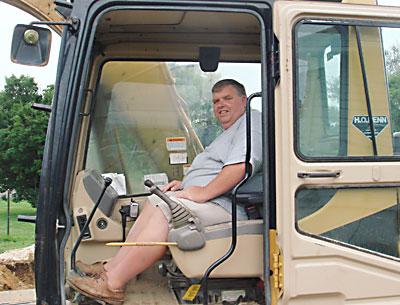And Miles to Go Before He Sleeps

With about 320 miles of road in the town highway system, maintenance is a constant item on East Hampton Town Highway Superintendent Steve Lynch’s to-do list.
This week, midway through a potentially pothole-producing winter, Mr. Lynch said that, despite budget and staffing cuts, and a fall repaving program that had to be suspended because of sub-par work by a paving contractor, he feels like he is getting a leg up on the task. Preventive maintenance, such as quickly sealing cracks that would allow water to seep in and undermine roads, has been key, Mr. Lynch said.
The goal for the roads, he said, is to “keep the good ones good, and keep pecking away at the bad ones.” A fairly gentle winter, so far, might have helped this year; Mr. Lynch said he has not received many complaints about the state of the roads.
In the years before he took office at the beginning of 2012, the Highway Department was repaving only about three to four miles of town road a year, Mr. Lynch said. His goal has been 12 miles.
Last year’s repaving efforts fell short, with “probably six or seven miles done,” Mr. Lynch said, because the poor quality of pavement being laid down led him to pull the plug on an outside company’s work, and begin efforts to have them redo the roads so as to meet engineering standards. Then Hurricane Sandy hit, focusing the Highway Department’s attention on clearing roads of debris, and the weather turned too cold for paving.
With the $925,000 for repaving in this year’s Highway Department budget by the town board, nine miles of road can be repaved in 2013, Mr. Lynch said.
Before a vote on the budget last fall, the town’s budget and finance advisory committee had recommended increasing the allocation for paving by 40 percent, to $1.4 million, so that more repaving could be done, but the budget was passed with the repaving amounts remaining as originally drafted by Supervisor Bill Wilkinson.
The advisers also recommended the purchase of a pavement management program that, after the input of data about the town’s roads, could help Mr. Lynch develop a long-range plan for scheduled maintenance and repair.
In a memo and presentation to the town board, the committee had said the additional funding was needed for a “catch-up plan” to address years of inadequate roadwork, as well as to maintain the level of funding needed to repair town roads at a rate equal to that of their deterioration. They said approximately 14 miles of road must be addressed per year, based on an expected span of 20 years between the need for a fix.
Bonnie Krupinski, a member of the committee, told the board that the cost of bringing neglected roads up to snuff could reach $25 to $30 million over the next few years.
The town board is expected to begin drafting this year’s capital budget in the coming weeks. Councilman Peter Van Scoyoc, the town board’s liaison to the Highway Department, said Tuesday that he supports including both the purchase of the pavement management system and more money for road paving. Money for capital projects is raised by issuing bonds, adding to the town’s long-term debt.
But, Mr. Van Scoyoc said, instituting an organized repaving system with the assistance of a computer program will allow the Highway Superintendent to “calculate which roads, given their condition,” need attention, and when, and to determine “what’s the best allocation of resources. I think it’s going to aid us in making the right choices,” he said.
Mr. Lynch said he expects both capital budget items to pass muster with the full town board. The inclusion of $250,000 for repaving in the upcoming capital budget, added to $250,000 for paving already listed in the capital spending plan, and the annual repaving allocation in the Highway Department’s budget, would mean almost $1.5 million for repaving, he said. With that, Mr. Lynch said, “If done right, I could get almost 15 miles of paving.”
And, he said, the long-range planning tool will set the course for future maintenance and repair. “This way you can keep it in the black,” he said. In the meantime, besides crack sealing, Mr. Lynch has also assigned workers to maintaining drainage structures and road shoulders, preventive maintenance that will preserve roads.
“By doing things differently, we can make everything last longer,” Mr. Lynch said. “We try to be as efficient as we can with what we have.”
The Highway Department is responsible only for roads in the town highway system; numerous roads in subdivisions, called “urban renewal roads” have not yet been improved to town highway standards and are not publicly maintained. However, a system of private payments by property owners in each subdivision, put to use to improve the urban renewal roads a bit at a time with an eye to having them eventually adopted as public roads, has been unsuccessful, prompting some residents in those areas to ask town officials for a solution.
The town’s first road improvement district, a tax district through which affected property owners will pay to have their roads improved so that they may be taken into the town system, has been formed and is now being reviewed by the state comptroller.
Mr. Van Scoyoc said that once the town starts accepting new roads into the system, ongoing maintenance demands will increase and “we will be further behind,” he said.
Mr. Lynch was operating this week out of temporary quarters in the hallway at the Highway Department barn while his office was being repaired. It had been “condemned,” he said, after a roof leak and problems with the ceiling. Mr. Lynch said he had experienced repeated bouts of illness, and an assistant had also become sick, and the air quality was found to be bad.
